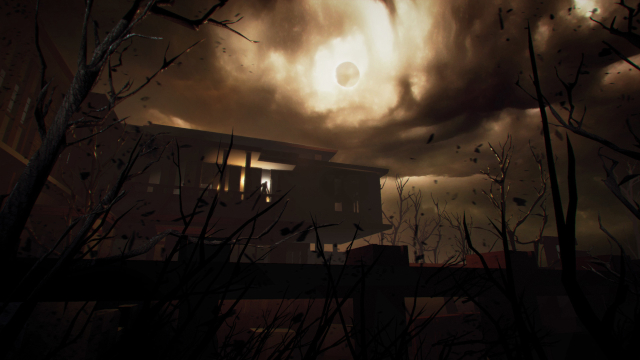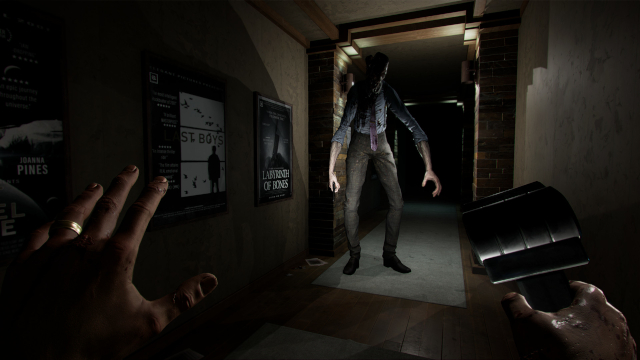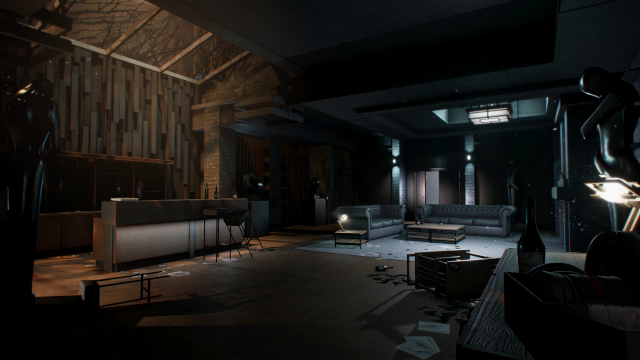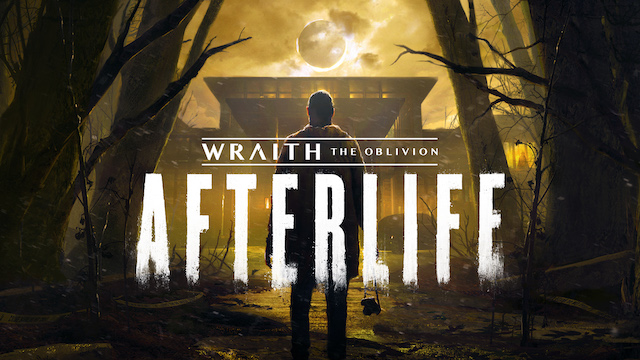The best part about a really good horror story is that it’s able to get under your skin and stay there long after it’s finished, and to that end, no other medium is more primal in its delivery of horror than virtual reality.
The creators of Wraith: The Oblivion — Afterlife harness VR to its fullest potential, forcing you to make the most of your real-world play area while delivering a healthy balance of molasses-thick tension, rich storytelling, and unforgettable scares.
Wraith: The Oblivion — Afterlife Review: Fantastic VR Horror
As horror survival games go, Wraith: The Oblivion — Afterlife is as unsettlingly “horror survival” as you can get in a VR headset. Given only a flashlight for self-defense, you’re left to your wits as you try to outrun various specters across a sprawling Hollywood mansion. In fact, this indelicate mixture of dimly lit grime and slow boil tension leads to some of the most satisfying thrills I’ve had in a VR headset this year.
In Afterlife, you play as the wraith of Ed Miller, a recently deceased photographer who mysteriously died while visiting the macabre Barclay Mansion, a once-upon-a-time staple of Los Angeles nightlife that fell into disrepair after a series of events went horribly wrong.
Now trapped in a mirror version of the condemned house located on a separate plane of existence called the Shadowlands, Ed is compelled to uncover the secrets of the dark force that’s keeping him there. Despite being a ghostly wraith, Ed is slow and fragile. Appropriately so; virtual reality is at its most tense when it makes you feel fragile and vulnerable, bumbling around in a confined space with a piece of plastic over your head.
The slower you move, and the more literal bumbling you do — peering around corners and moving items around with your hands — the more grounded you are in that world. It’s something we praised Half-Life: Alyx for doing so well, noting that it greatly benefited as a VR exclusive for that exact reason. And Wraith: The Oblivion — Afterlife absolutely nails it.

Wraith‘s 6- to 8-hour campaign takes full advantage of this slow-burn style of gameplay. Like in Resident Evil, Alien: Isolation, or the Jeff section of Half-Life: Alyx, you spend significant portions of your adventure being stalked by unkillable monsters called specters. Throughout, you run afoul of about four different specters that creep around the grisly Barclay Mansion. To be absolutely clear: these enemies are much more lethal than you, each with the means to rip you to shreds.
But these encounters are appropriately balanced out. About half of Wraith is spent poking around for photos and evidence. The other half is spent crawling around, staying quiet, and throwing bottles or other objects to distract a shadowy stalker. Since Barclay Mansion is so dark and dreary, much of the thrill is not knowing exactly what’s ahead of you. This means that you need to take every precaution to be as stealthy and deliberate as you can.
At least on the Quest 2 version, your view distance is heavily cut down, obscuring distant objects. Meanwhile, silhouettes of ominously-shaped statues and furniture contrast against mold-coated walls and ceilings, making every moment feel uneasy even if there’s no imminent danger.

You’re given a few items, including the flashlight I mentioned earlier, as well as a camera that shows past conversations marked by ghostly photographs. You also have a voice recorder that functions as a key to certain locked doors and lockboxes. Random items in the world, like bottles and rocks, can be picked up and thrown for a quick distraction, which is always nifty and feels great to do in VR.
In addition to that, you can grab and pull distant objects over to you, much like you can do by using the Gravity Gloves from Alyx. But it’s a bit rougher around the edges here and isn’t quite as reliable as you’d expect.
Your limited selection of items does feel a bit rudimentary. Wraith certainly covers the basics expected in a horror survival game where you need to run or hide rather than fight, but I’d have loved to have seen even more variety in the tools at my disposal.
As you move around Barclay Mansion, you need to avoid stepping on piles of broken glass or running too fast lest you attract unwanted attention. But even if you make a mistake, there’s always a save point close behind. They’re conveniently scattered throughout the mansion, allowing you to restore health and flashlight juice (called Pathos) or travel to a place called the Memory Palace, where you can view every note or piece of evidence you’ve collected thus far.
This level of convenience might make the horror more predictable — a tactical save point usually precedes a sequence where you need to evade a stalker — but for me, this toes the line perfectly between too scary or too hard and not scary or hard enough.
Specters in Wraith: The Oblivion — Afterlife are equally as terrifying from a distance as they are up close. Just seeing their visage as they turn a corner or pop out of a doorway has so much more impact in VR than comparable experiences on a flat screen, but the real thrill is when they finally catch up to you, forcing you to evade them.
There’s something palpably blood-curding about trying to close a door in VR to put distance between yourself and an assailant, only to see it swing right back open as they climb through it.

Not only is it necessary to have your volume cranked up to keep track of where a specter is, but the intermittent sounds of shrieks and creaky floorboards add so much tension that it’s sometimes impossible to know if there’s a real threat looming around the corner. It instills a sense of risk vs. reward in Wraith‘s moment-to-moment gameplay; are you afraid to find out what’s behind that door? You should be.
One section even forces you to use voice recordings to open various lockboxes to pick up items needed to progress, attracting the attention of the resident specter and forcing you to get creative in how you plan your escape route. It’s as fearsome as you expect, and it stuck with me well after I beat the campaign.
Without spoiling too much, each specter has a unique appearance and set of behaviors, with each of their gruesome features relating directly to how they lived and died in Barclay Mansion. The Tall Man, for example, stalks the vaulted hallways of Barclay Mansion’s office complex. Meanwhile, the mangled Broken Woman is first spotted in the Guest House, where one of Barclay Mansion’s darkest secrets is kept.
Throughout the campaign, you uncover the stories of what happened to each of these characters. And, for lore fanatics, it’s great that the overarching storyline of Wraith: The Oblivion — Afterlife pulls directly from — and ties directly into — World of Darkness, an era-old tabletop RPG series that’s brimming with backstory. If you’re familiar with Vampire: The Masquerade, Werewolf: The Apocalypse, or even just Wraith: The Oblivion, the lore and worldbuilding here are absolutely fleshed out enough to be worth fully uncovering.
Wraith: The Oblivion — Afterlife Review: Fantastic VR Horror

Pros
- Deeply engrossing use of VR controls
- Scary as hell
- Great use of limited draw distance and dark colors to instill an aura of tension
- Tons of interesting lore and story to uncover
Cons
- Only a few tools at your disposal
- Not for the weak of heart (or stomach)
- Could have been longer!
Wraith: The Oblivion — Afterlife is a wonderful example of what a pure horror survival game made exclusively for VR can be. It forces you to be slow and deliberate. It rewards you for making the most use of your physical play area as you slip out of harm’s way or sniff out Barclay Mansion’s many secrets. It also hosts a cast of interesting characters, and each of its monstrous specters has a fascinating backstory to seek out.
Unfortunately, there are only so many ways to fend them off, and the relentless tension might make some players check out early.
But if you play Wraith to the very end, you’re rewarded with an experience that exhilarates as much as it terrifies, sticking with you and keeping your mind occupied well after the credits roll.
[Note: Fast Travel Games provided the copy of Wraith: The Oblivion — Afterlife used for this review.]







Published: May 14, 2021 01:36 am